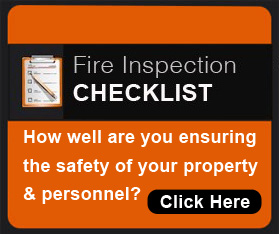An exploration of solutions for fire suppression, damage control, and safety at your Toronto-area industrial or manufacturing facility.

Multiple major fires at industrial and manufacturing facilities have made the local Ontario news recently. Some recent examples come to mind:
- Canada Pallet plant in Cobourg, Ontario, est. $10-30K damage; fire started by machine overheating. Damage contained by sprinklers, exhaust systems, aided by well-trained employees.
- GlobalMed plant warehouse in Trenton, Ontario, cause of fire unknown. Fire isolated to one part of the warehouse with the help of sprinklers, GlobalMed’s own fire brigade and Trenton firefighters. Toxic fumes were involved. No estimate of damage available.
- Roslin Enterprises, a cooking oil recycling facility in Blandford-Blenheim, Ontario, cause of fire unknown. Damage estimates were in the ballpark of $5 million.
- Liberty Tire recycling plant in Brantford, Ontario, fire apparently started in a hopper. Damage was estimated between $100-$500K.
- Also noteworthy are a pair of similar explosions in British Columbia sawmills (Babine Forest Products in Burns Lake and Lakeland Mills in Prince George). Though further away, these have drawn great attention for the extent of devastation and the issue of combustible dust and dust control, particularly at sawmills and wood-processing facilities. These incidents resulted in fines of $1M and $724M for the companies related to unsafe work conditions, as employees were killed and dozens injured. Many factors contributed to the explosions but a report on the fire at Lakeland Mills indicates it started when a gear-reducer cooling fan failed, leading a rotating shaft to generate friction, heat and a temperature of 577 degrees Celsius. Inadequate dust control and dust collection measures led to primary and secondary explosions, leveling the mill.
The Abnormal Situation Management (ASM) Consortium also keeps a running log of media reports of global incidents involving process industries, many of which are fires and explosions.
Research on Fire Damage in Manufacturing and Industrial Facilities
- A 14 year study of 946 serious fires between 2000-2013 by Liberty Mutual Insurance’s Property Risk Engineering Group (in NFPA Journal) found that fires in non-sprinklered facilities averaged an estimated $1.9M damage vs. $638,000 in sprinklered facilities, or a ratio of about 3:1. Of the fires they studied, 322 were industrial fires; 269 were in manufacturing centers; 53 were in warehouses.
- A 2012 National Fire Protection Agency (NFPA) study of Structure Fires in Industrial and Manufacturing Properties found an average of 8,600 structure fires in industrial and manufacturing properties each year between 2006 and 2010. The yearly averages for those years were 11 civilian deaths, 230 civilian fire injuries, and $753 million in direct property damage per year.

What Are Your Fire Suppression Options?
When you need to protect your machines from fire, options include standards like fire extinguishers, fire signs and labels, fire doors and emergency lighting. But if your plan depends on the ability to control small fires with portable extinguishers, keep in mind that machines often ignite within seconds of a spark, fires are often hidden from view in machinery, they may occur when no worker is nearby, and explosions may happen before there is time to react. So even with well-trained and willing workers, that plan may be unrealistic. Your fire safety measures should work without human intervention.
Additionally, overhead fire sprinklers may be required by code, but even they may not go as far as you need to limit your property damage. The best fire safety plan for you will be made as a strategic business decision, as well as a compliance requirement.
Here is a look at two types of fire suppression tools for the industrial and manufacturing environment:
Wet-pipe Sprinklers
People often worry that sprinklers will damage expensive equipment. They might. But it’s much more likely that they will save more of your equipment, personnel and the building itself, putting a serious dent in your potential loss. In NFPA studies of fires in manufacturing facilities, deaths were 88% lower and direct property damage was 38% lower where wet pipe sprinklers were present. A number of studies of manufacturing, industrial, and warehouse fires ballpark the savings from fire sprinklers at approximately 3 to 1 (or more) when comparing damage costs for sprinklered facilities to non-sprinklered facilities (see Liberty Mutual and Business Sprinkler Alliance studies). Considering the clear benefits, it’s a shame that as recently as 2007-2011, sprinklers were present in only 48% of manufacturing facilities during reported fires.
The extent of your potential damage depends greatly on the type of fire suppression system you install. Sprinklers only operate at the source of fire; with the vast majority (88%) of wet-pipe sprinkler systems using just one or two sprinkler heads to control a fire. This limits damage from either the fire or the sprinkler to a confined area, while preventing the spread of fire and more extensive damage. And, your odds of taking a loss on a machine are greater when it is subjected to fire (or even the high pressure water hoses used by the fire department) versus water from a fire sprinkler.
The NFPA has been keeping statistics on fire sprinklers since 1896, for over 100 years. Their data show wet pipe sprinklers operated in 86 percent of fires and operated effectively in 84 percent of fires. You can read more about fire sprinklers here. Sprinklers offer fire suppression you can count on, but because of the unique fire risks and costly equipment in manufacturing environments, you may need to go even further to protect your business.
Clean Agent or Gaseous Suppression Systems
If you want to protect your machines, you may consider supplementary options such as foam or dry chemicals to extinguish combustibles used in machine tooling. Clean agents are gasses with extinguishing capabilities that “wash” machinery, inside and out, even in hard to reach areas inside machines. They can be used locally (directly on a fire), or via a “total flooding” mechanism. Both approaches are designed to extinguish a fire in its incipient stage, before it would even generate enough heat to activate the sprinkler system.
Clean agents are non-toxic and are effective on Class A, B, and C fires. They are nonconductive, noncorrosive, do not leave residue and will not harm your machinery or contaminate the expensive oils used in CNC machines. Halon, which was previously used, has been phased out since its environmental risks were identified in 1987. You can learn more about the types of clean agents from the Fire Suppression Systems Association here.
Local application of clean agents is likely the best match for most manufacturing or industrial facilities, though it depends on your specific needs. An example of a locally applied clean agent solution is one featured recently on both Production Machining and Modern Machine Shop. It’s a supplementary fire suppression system by Firetrace International designed to protect the CNC machines used in industrial machining centers. It’s integrated at the machine level, using pressurized tubing which bursts when exposed to fire and releases an extinguishing agent. There are many different options to customize this solution but Modern Machine Shop says typical installations cost about $3,000-$4,000 per machine and can detect a fire 10 times faster than other methods. It operates without electricity, allowing it to also protect equipment that has been powered down.
(Note: the mentions in Production Machining and Modern Machine Shop appear influenced by Firetrace International rather than being strictly editorial or third-party reporting, and our mention should not be taken as an endorsement. However, it still provides an excellent example of a machine-level fire suppression solution specifically designed for the manufacturing environment. It is not the only available option). This type of solution is definitely worth further research and consideration if you use costly machinery.
Here's a video of another suppression solution for machine tools from Siemens.
Total flooding gaseous suppression systems may be a less likely solution for manufacturing facilities, unless you have property so costly or irreplaceable that the higher cost is warranted. They require airtight, enclosed spaces and are more costly due to their complexity, with an estimated $3-$5 cost per cubic foot (according to Buildings Magazine). They are often used in electrical rooms, computer rooms, and for art and culture collections.
Other Considerations: Explosion Suppression Technology & Titanium Fires
Manufacturers should also be aware of explosion suppression technology. There has recently been significant attention to safety concerns around dust explosions (such as those that occurred at sawmills in British Columbia). For that reason, the use of explosion suppression systems is on the rise. They include three parts: pressure sensors, an extinguishing agent (such as carbon dioxide, halon substitutes, or water), and a control panel. These systems are more complex, so to get a better idea of how they work, here is a video illustrating one company’s explosion suppression solution:
Also, if your manufacturing facility works with metals like titanium there are additional fire risks and considerations to be ready for a Class D fire. The NFPA has said the average damage to a sprinklered building in a heavy metal manufacturing fire is $819,000, while the average damage for similar fires in non-sprinklered buildings is $3,100,000, which is also consistent with the 3:1 (or more) savings ratio seen in other studies comparing damage in sprinklered versus non-sprinklered buildings.
Additional Resources:
We've put together a Starter Guide to Safety Options for Manufacturing Facilities which includes some initial questions to consider as you explore your options and start doing a cost-benefit analysis of your choices.
If you are in the greater Toronto area, don’t hesitate to call on Rohen with questions about fire safety for your manufacturing or industrial facility.
Get more information and ideas in our new Starter Guide:


